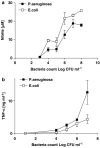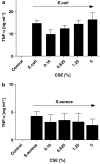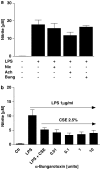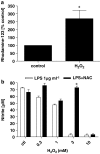Cigarette smoke inhibits macrophage sensing of Gram-negative bacteria and lipopolysaccharide: relative roles of nicotine and oxidant stress
- PMID: 18059323
- PMCID: PMC2241791
- DOI: 10.1038/sj.bjp.0707595
Cigarette smoke inhibits macrophage sensing of Gram-negative bacteria and lipopolysaccharide: relative roles of nicotine and oxidant stress
Abstract
Background and purpose: Smoking cigarettes is a major risk factor for the development of cardiovascular and respiratory disease. Moreover, smokers are more prone to infections. This has been associated with a suppression of the immune system by smoke. However, it is not clear how cigarette smoke affects the ability of immune cells to sense pathogens. Cigarette smoke contains a large number of molecules which may mediate responses on immune cells and of these, nicotine and oxidants have both been identified as inhibitory for the sensing of bacterial lipopolysaccharide (LPS). Nitric oxide synthase (NOS) and tumour necrosis factor (TNF)-alpha are both induced in macrophages on stimulation with Gram negative bacteria or LPS.
Experimental approach: We used murine macrophages stimulated with whole heat-killed bacteria or LPS. We measured output of NO (as nitrite) and TNFalpha, NOS protein by Western blotting and cellular oxidant stress.
Key results: Cigarette smoke extract suppressed the ability of murine macrophages to release NO, but not TNFalpha in response to whole bacteria. Cigarette smoke extract also inhibited nitric oxide synthase II protein expression in response to LPS. The effects of cigarette smoke extract on nitrite formation stimulated by LPS were unaffected by inhibition of nicotinic receptors with alpha-bungarotoxin (100 units ml(-1)). However, the effects of cigarette smoke extract on LPS-induced nitrite formation were mimicked by hydrogen peroxide and reversed by the anti-oxidants N-acetyl cysteine and glutathione.
Conclusions and implications: We suggest that cigarette smoke exerts its immunosuppressive effects through an oxidant-dependent and not a nicotine-dependent mechanism.
Figures








References
-
- Bartal M. Health effects of tobacco use and exposure. Monaldi Arch Chest Dis. 2001;56:545–554. - PubMed
-
- Borovikova LV, Ivanova S, Zhang M, Yang H, Botchkina G, Watkins LR, et al. Vagus nerve stimulation attenuates the systemic inflammatory response to endotoxin. Nature. 2000;405:458–462. - PubMed
-
- Cho IJ, Lee AK, Lee SJ, Lee MG, Kim SG. Repression by oxidative stress of iNOS and cytokine gene induction in macrophages results from AP-1 and NF-kappaB inhibition mediated by B cell translocation gene-1 activation. Free Radic Biol Med. 2005;39:1523–1536. - PubMed
Publication types
MeSH terms
Substances
Grants and funding
LinkOut - more resources
Full Text Sources

